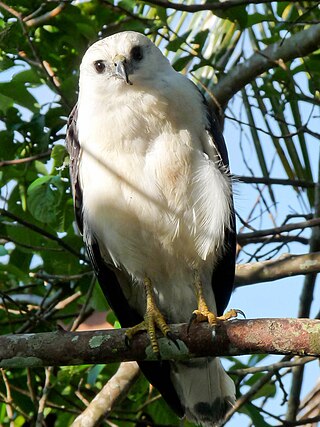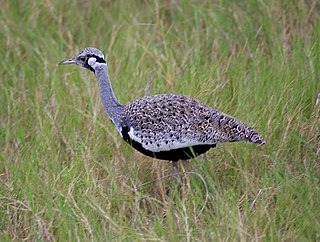
The hoatzin or hoactzin is a species of tropical bird found in swamps, riparian forests, and mangroves of the Amazon and the Orinoco basins in South America. It is the only extant species in the genus Opisthocomus which is the only extant genus in the Opisthocomidae family under the order of Opisthocomiformes. The taxonomic position of this family has been greatly debated by specialists, and is still far from clear.

Opisthocomidae is a family of birds, the only named family within the order Opisthocomiformes. The only living representative is the hoatzin which lives in the Amazon and the Orinoco delta in South America. Several fossil species have been identified, including one from Africa and one from Europe.

The common snipe is a small, stocky wader native to the Old World.
Philipp Ludwig Statius Müller was a German zoologist.

In zoology, a folivore is a herbivore that specializes in eating leaves. Mature leaves contain a high proportion of hard-to-digest cellulose, less energy than other types of foods, and often toxic compounds. For this reason, folivorous animals tend to have long digestive tracts and slow metabolisms. Many enlist the help of symbiotic bacteria to release the nutrients in their diet. Additionally, as has been observed in folivorous primates, they exhibit a strong preference for immature leaves which tend to be easier to masticate, are higher in energy and protein, and lower in fibre and poisons than more mature fibrous leaves.

The mollymawks are a group of medium-sized albatrosses that form the genus Thalassarche. The name has sometimes been used for the genus Phoebetria as well, but these are usually called sooty albatrosses. They are restricted to the Southern Hemisphere, where they are the most common of the albatrosses. They were long considered to be in the same genus as the great albatrosses, Diomedea, but a study of their mitochondrial DNA showed that they are a monophyletic taxon related to the sooty albatrosses, and they were placed in their own genus.

Butastur is a genus of birds of prey in the family Accipitridae.

The white-necked hawk is a Vulnerable species of bird of prey in subfamily Accipitrinae, the "true" hawks, of family Accipitridae. It is endemic to Brazil.

Lissotis is a genus of bird in the bustard family, Otididae. Some authorities, such as the IUCN, consider it part of Eupodotis; the separation adopted here follows the Handbook of the Birds of the World.

Tinamotis is a genus of birds in the tinamou family.

Rhynchotus is a genus of birds in the tinamou family. This genus comprises two members of this South American family.
Hoazinoides is an extinct genus of birds from the Middle Miocene (Laventan) from the "Monkey Beds" of the Villavieja Formation of the Honda Group at the Konzentrat-Lagerstätte of La Venta, Colombia.

Nothurinae or aridland tinamous is one of two subfamilies of the Tinamidae family, the other being Tinaminae. It contains eighteen species in six genera. The six genera are:
Hoazinavis is an extinct genus of early hoatzin from Late Oligocene and Early Miocene deposits of Brazil. It was collected in 2008 from the Tremembé Formation of São Paulo, Brazil. It was first named by Gerald Mayr, Herculano Alvarenga and Cécile Mourer-Chauviré in 2011 and the type species is Hoazinavis lacustris.
Namibiavis is an extinct genus of early hoatzin from early Middle Miocene deposits of Namibia. It was collected from Arrisdrift, southern Namibia. It was first named by Cécile Mourer-Chauviré in 2003 and the type species is Namibiavis senutae.

Eurypygiformes is an order formed by the kagus, comprising two species in the family Rhynochetidae endemic to New Caledonia, and the sunbittern from the tropical regions of the Americas. Its closest relatives appear to be the tropicbirds of the tropical Atlantic, Indian, and Pacific oceans.

Afrotis is a genus of bustard in the family Otididae. The genus is endemic to southern Africa, and contains two species. It is sometimes included in the genus Eupodotis.

Gruae is a clade of birds that contains the order Opisthocomiformes (hoatzin) and Gruimorphae identified in 2014 by genome analysis. Previous studies have placed the Hoatzin in different parts of the bird family tree; however, despite its unusual and primitive morphology, genetic studies have shown the hoatzin is not as primitive or as ancient as once thought, and that it could be a very derived bird that reverted to or retains some plesiomorphic traits.

Inopinaves is a clade of neoavian birds recovered in a compressive genomic systematic study using nearly 200 species in 2015. It contains the clades Opisthocomiformes (hoatzin) and Telluraves ; the study shows that the hoatzin diverged from other birds 64 million years ago. Previous studies have placed the hoatzin in different parts of the bird family tree; however, despite its unusual morphology, genetic studies have shown the hoatzin is not as primitive or as ancient as once thought; it could be a very derived bird that reverted to or retains some plesiomorphic traits.

This is a list of the tallest extant birds according to maximum height. Birds range from a tiny bee hummingbird, which is only 5–6 cm (2.0–2.4 in), to the giant African ostrich, almost 280 cm (9.2 ft) in height.













